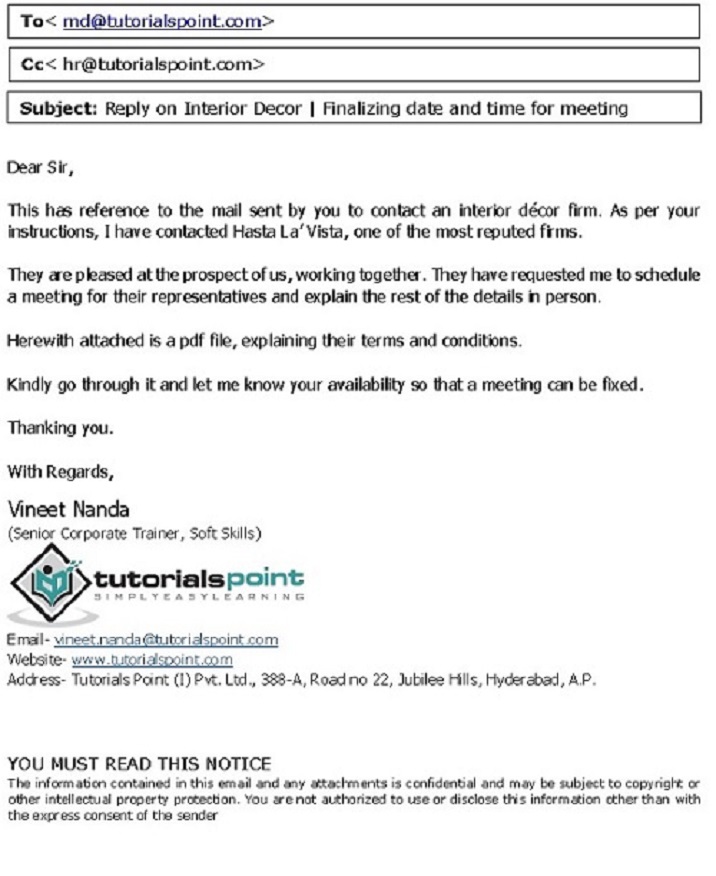
- Business Etiquette - Home
- Business Etiquette - Introduction
- Defining Business Etiquette
- Business Etiquette - Significance
- Importance of First Impression
- First Impression WorksheetⅠ
- First Impression WorksheetⅡ
- Qualities That Form Etiquettes
- Grooming Etiquettes
- Grooming Etiquette Worksheet
- Dining Etiquettes
- Rules of Writing
- Writing The Documents
- Email Etiquette
- Telephone Etiquette
- Business Etiquette - Across Borders
- Business Etiquette - Conclusion
Email Etiquette
Email is widely used as a form of inexpensive yet highly effective business communication tool. Printouts of emails are rarely taken and soft copies are used because archiving and retrieving emails is easily. The reason of its popularity is the ease of access, which everyone in an organization starting from the CEO to the janitor can use.
Emails are an efficient way to communicate information in a well-presented, easy to read and professionally appropriate manner. Many people quote lack of time as a reason to forward sub-standard emails that range from incomplete to incomprehensible.
Many people mistake emails with text messaging, or at least their approach towards writing emails suggests so. Let us discuss the difference between a text conversation and writing email. In a text message conversation, two people can exchange information, share details, provide corrections and ask for clarifications in a rapid back-forth manner of communication.
Compared to this, emails are read by professionals who, depending on their work, may get anything between 20 to 200 emails a day. They neither want to engage in a back-and-forth conversation, nor have the time to ask for details, multiple times. They just want to understand the content of the email, read out the instructions, process the information, get the task done and empty the "unread" section of the inbox.
Keeping this in mind, let us discuss some tricks to write effective emails −
- Plan your message.
- Use the subject line to grab the readers attention.
- Keep your message short and clear.
- Do not type your entire message in lower case.
- Proofread your message before sending it and assume accountability.
- Take a few minutes to cool down before sending any email while angry.
- Do not type your message in capitals. Capitals are considered to be SHOUTING.
In certain cases, emails may not be suitable. Prefer to call someone when −
- You have to discuss personal, sensitive or confidential information.
- You are going to give bad news.
- Your message is complex and meaning might be lost in the wordings.
- you need an immediate response.
Legal Risks of Emails
Emails are the preferred mode of communication in many workplaces, and this means they carry a lot of information that could be confidential. Many companies train people extensively on how they are supposed to frame their emails and what kind of emails, to whom they are supposed to forward.
The security and confidentiality of the information in the emails is the joint responsibility of both the sender and the recipients. Companies have strict guidelines to safeguard their documents and their contents. Let us discuss some of the most commonly followed guidelines to prevent email misuse.
You and your company will be held liable for numerous legal suits if −
- You send or forward emails with offensive content.
- You send an attachment that has a virus.
- You forward the senders email to another person without permission.
- You try to forge others emails or send emails from others accounts.
- You try to conceal your identity from the receivers when sending email.
- You copy a message belonging to another person without permission.
Elements of a Formal Email
While most of us send informal emails to friends that might contain grammatical mistakes in them, the same is not true when writing to colleagues, especially when we want to make a good impression, as we have to be more careful and diplomatic this time. Here are some general tips on the right format of an email −
Background − The default white background should be used for all emails. Colored backgrounds, or scroll designs seem to be unprofessional and distracting.
Font − Preferred fonts are Times New Roman or Arial, Font size-12.
Font Color − Font should be navy blue or black only.
Contact Details − Official contact information like name, designation, email id, contact number, company logo and address of correspondence should be mentioned in the signature area. Personal statements are best avoided.
First Name and Surname − They should be mentioned in the same font as used in the body of the email, only two font sizes larger. Cursive fonts for name is not recommended.
(To be mentioned in the same font and size as body of the email)
- Designation
- Department
- Company Name & Address
- Landmark & ZIP Code
- Contact Number
- Email address
- Company telephone number
- Company fax number
- Company URL
- Disclaimer
Example of Email
